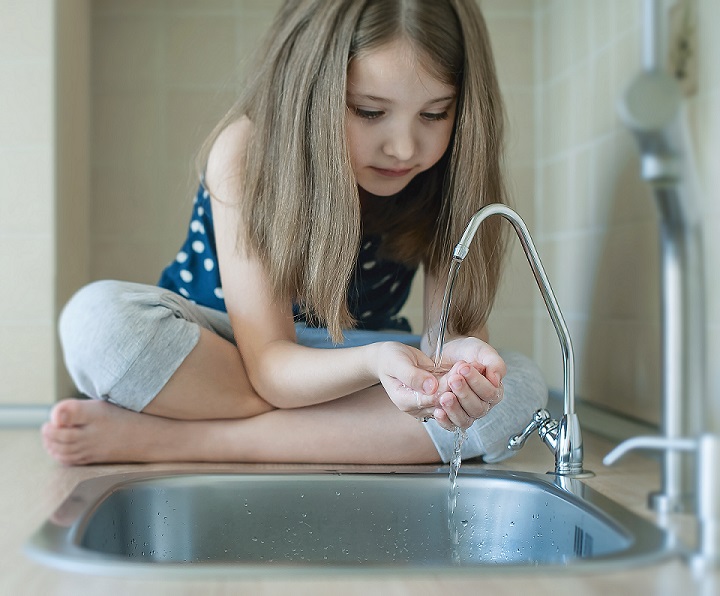After years of hearing about how sodas and other sugary drinks can lead to all kinds of health issues, it seems that Americans are finally getting the message about the health benefits of drinking water. Indeed, bottled water consumption finally passed soda for the first time in 2016 and continues to grow nationwide. While we now know that drinking water is a smart and healthy decision, there are still choices to be made when figuring out what kind of water to drink.
After the Flint, Michigan water crisis, you have every right to be concerned about the possibility of dangerous materials like lead in your local water system. Since you don’t want your family exposed to contaminated water, it might be the right time to look into a water filtration system that uses reverse osmosis.
What Is Reverse Osmosis Water?
Before looking at the benefits of a reverse osmosis water system, it helps to understand how this system works. Reverse osmosis is basically a chemical treatment process for water. By forcing water through specialized membranes, it takes out solid substances, large molecules and minerals, and contaminants. Essentially, it’s a water purification system that makes water safe for cooking, drinking and other uses.
Regardless of where you live, there’s much more than just H2O in the water in your home. The powerful filtration in a reverse osmosis system can reduce contaminants by getting rid of harmful molecules. For instance, it can filter out calcium deposits that can harden your water and hurt your skin. This process will also filter out solids and chemical compounds. Furthermore, it will eliminate fertilizers, pesticides, and other harmful organic materials that may be lurking in your tap water.
Safe for Cancer Patients
Cancer patients suffer from weakened immune systems, especially after receiving radiation or chemotherapy. And drinking contaminated water could add to their health problems by causing infection. Fortunately, reverse osmosis water is safe for cancer patients because it doesn’t have any parasites or harmful microbes. In addition, patients can also use reverse osmosis water for cooking, thereby avoiding tap water, which may contain bacteria and other harmful compounds.
Removes Lead
Lead is one of the most common contaminants in drinking water supplies throughout the United States. When old pipes corrode, lead seeps into our water systems. As we mentioned earlier, Flint has been notorious for its lead contamination. Nevertheless, it is far from the only city with a problem. In fact, both children and adults have tested positive for lead in many cities on account of contaminated water.
Even small amounts of lead can be dangerous to people. For this reason, the EPA recommends that no lead be present in public drinking water. Elevated lead levels in the body can cause things like high blood pressure, nerve damage, fertility issues, brain damage and more. Reverse Osmosis, however, can effectively remove lead and make it safe for consumption.
Saves Money Spent on Bottled Water
One of the huge advantages of a reverse osmosis water filtration system is the money it saves you from buying bottled water. Not only is bottled water expensive, but it harms the environment by contributing to landfills since much of it goes unrecycled. Furthermore, bottled water is often not nearly as pure as you imagine. Often, it’s just filtered tap water.
On the other hand, a reverse osmosis system will pay for itself quickly because you’ll only be paying pennies per gallon. And instead of having to go out and buy clean water, it will be right there at the tap.
Reverse Osmosis Cuts Down on Sodium Levels in Soft Water
Although water softeners may solve your hard water issues, they are not really designed for purification. A water softener will give you water that’s great for bathing, cleaning, and doing laundry. However, not everyone likes the taste of softened water. it also may have higher levels of sodium. Fortunately, a reverse osmosis water system can filter out the sodium that your water softener adds.
In fact, reverse osmosis removes between 90 to 95% of sodium from water supplies. Sodium can get into your water system for a number of reasons such as water treatment methods and ion water units. If you are drinking many glasses of water per day, you can consume a fair amount of sodium. Too much sodium can cause high blood pressure, which may trigger heart disease and kidney or liver problems.
Therefore, reverse osmosis can help people with these kinds of problems or those with sodium restrictions.
It’s Much Better for Cooking
Impurities from your home’s water system such as chlorine will naturally affect the taste of the food you cook. Too much chlorine can also discolor food as well. It’s no secret that many restaurants choose reverse osmosis-filtered water for cooking. Making coffee, tea, soup, and boiling pasta with filtered water can really improve its taste along with making it healthier.
The greatest benefit of drinking osmosis water is its purity level. Reverse osmosis water is one of the only drinking sources that contains no minerals or impurities. And eliminating chemical compounds and contaminants also give reverse osmosis water a refreshing taste that’s tough to beat.




